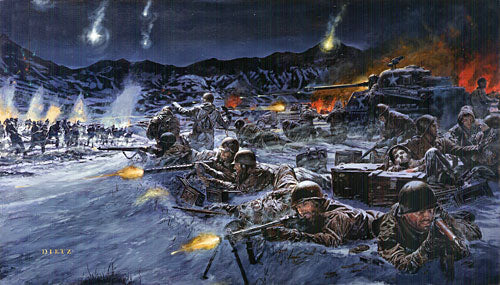
First Victory by James Dietz
RARE PRINT, LIMITED SUPPLY
Image Size: 31" x 18"
100 Publisher Proof Edition (Limited Edition, Signed and Numbered)
100 Artist Proof Edition (Limited Edition, Signed and Numbered)
1000 CGSOC Class of 2000 Edition (Limited Edition, Signed and Numbered)
Battle of Chipyong-ni
February 13 - 14, 1951
"We are going to stay here and fight it out." With these words, LTC Paul Freeman, Commander of the 23rd Regimental Combat Team, set the stage for the bloody battle of Chipyong-ni. During the early evening hours of 13 February, 1951, Freeman briefed his subordinate commanders of the daunting task ordered by the Eight U.S. Army Commander, LTG Matthew Ridgeway. Listening intently to this briefing were all of Freeman's battalion commanders, leaders from the 37th Field Artillery Battalion, the 1st Ranger Company, and a French infantry battalion. LTC Freeman quickly outlined the mission, "to hold the small American garrison at Chipyong-ni against an advancing enemy force of six Chinese Communist Force (CCF) Divisions." The importance of the village of Chipyong-ni was its location at the junction of several crucial road networks. A failure to hold the village would endanger the entire Eighth Army.
His orders clear, LTC Freeman's subordinates prepared for the inevitable onslaught. Shortly after midnight, the deafening sound of whistles and bugles signaled the initial Chinese attack. This first relentless attack was met and defeated by the professional French battalion commanded by LTC Ralph Monclar. Throughout the night, the Chinese would attack the perimeter no less than 4 times, and although the perimeter held, the exhausted men were short of ammunition and food as dawn broke of the morning of 14 February, 1951. The Chinese forces, fearing the devastating effect of observed artillery fire and air strikes, broke contact, withdrew and prepared to resume the fight.
Shortly after nightfall, flares soaring in the air, accompanied with the sound of sirens and brassy bugles, whistles and yells echoing through the cold, night air signaled the beginning of an endless night of Chinese attacks against to perimeter. After the savage and relentless attacks by the hordes of Chinese, bitter hand to hand fighting restored the perimeter and drove back the Chinese penetrations of the friendly lines. A gallant defense by the men of the 23rd RCT refused to yield as orders were transmitted to the embattled line to conserve ammunition as much as possible. The fighting continued to rage fiercely as daylight broke on the morning of 15 February. As the garrison tenaciously held the Chinese hordes at bay, deadly air strikes effectively dropped napalm, which destroyed hundreds of enemy troops. Countless planeloads of ammunition were dropped to the beleaguered men as a relief convoy of twenty tanks from the 5th Cavalry Regiment moved to the aid of the 23rd RTC. The arrival of the relief column, coupled with the deadly strafing and napalm attacks and the equally fierce American defensive stand, had finally broken the enemy attack.
Fifty-two members of the 23rd RTC died, 259 were wounded and 42 men were reported missing in action during the two-day long Battle Chipyong-ni. The battle of Chipyong-ni resulted in the defeat of a massive Chinese offensive and caused the CCF to suffer its first tactical defeat at American hands. Although the CCF would try again and again, the battle of Chipyong-ni set a new pattern in the Korean War. The 23rd RTC had stood in the face of all that the armies of China could muster. Despite overwhelming odds and sickening casualties, it had held fast. Chipyong-ni allowed the Eighth Army to rise from its own bitter ashes. From this battle forward, the Eighth Army would never fall again.
